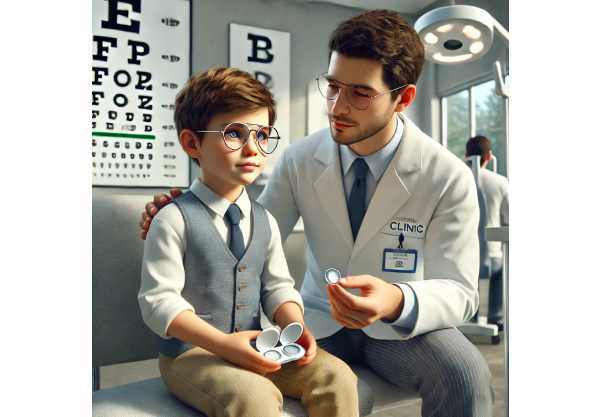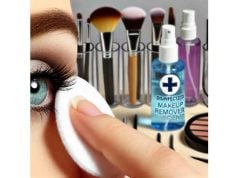
As parents explore options to correct their children’s vision, contact lenses often emerge as an appealing alternative to traditional eyeglasses. The idea of providing children with the freedom to engage in physical activities without the hindrance of glasses is attractive to many families. However, the question remains: can children wear contact lenses safely? Concerns about hygiene, responsibility, and the potential risks associated with improper use naturally come to mind. Understanding the factors that determine whether a child is ready for contact lenses, as well as the benefits and potential drawbacks, is essential for making an informed decision.
Children as young as eight years old can be considered for contact lenses, depending on their maturity and ability to handle the responsibilities that come with wearing them. While contact lenses offer numerous benefits, such as improved peripheral vision and a sense of normalcy in social situations, they also require strict adherence to hygiene and care routines.
The Benefits of Contact Lenses for Children
Contact lenses offer several advantages that make them an attractive option for children. These benefits go beyond mere aesthetics, contributing to better vision, enhanced confidence, and greater freedom in daily activities.
Improved Vision and Peripheral Awareness
One of the primary benefits of contact lenses is the improvement in visual acuity and peripheral vision. Unlike glasses, which only correct vision directly in front of the wearer, contact lenses move with the eye, providing a full field of clear vision. This can be particularly beneficial for children involved in sports or other activities that require sharp peripheral awareness. For instance, a child playing soccer will benefit from the unobstructed view that contact lenses provide, allowing for quicker reactions and better performance on the field.
Increased Confidence and Social Comfort
Wearing glasses can sometimes affect a child’s self-esteem, especially if they feel different from their peers. Contact lenses can help alleviate these concerns by offering a more natural appearance. Children who switch to contact lenses often report feeling more confident and socially comfortable. This boost in confidence can translate to better performance in school and extracurricular activities, as well as improved social interactions.
Enhanced Comfort During Physical Activities
Children are naturally active, and glasses can sometimes be a hindrance during physical activities. Contact lenses eliminate the risk of glasses breaking during sports, provide a more stable visual experience, and do not fog up or slide down the nose. This makes them a preferable option for children who engage in sports, dance, or other vigorous activities. Moreover, contact lenses can be particularly useful for children who participate in activities that require helmets or other headgear, as glasses can be cumbersome in these situations.
Better Vision Correction for Certain Conditions
For some children, contact lenses may offer better vision correction than glasses. For instance, children with high prescriptions or conditions like astigmatism can benefit from the more precise correction that contact lenses provide. Additionally, contact lenses can be used for myopia control, a treatment strategy aimed at slowing the progression of nearsightedness in children. Specialty lenses, such as orthokeratology (Ortho-K) lenses, are worn overnight to gently reshape the cornea, providing clear vision during the day and potentially reducing the progression of myopia.
Assessing a Child’s Readiness for Contact Lenses
Determining whether a child is ready for contact lenses involves assessing several factors, including their maturity, responsibility, and ability to follow proper hygiene practices. While age can be a factor, it is not the only consideration.
Maturity and Responsibility
The primary factor in deciding if a child is ready for contact lenses is their level of maturity and responsibility. Contact lenses require diligent care to prevent infections and other complications. Children need to be responsible enough to handle the daily tasks of cleaning, storing, and wearing contact lenses correctly. This includes washing their hands before touching the lenses, following the recommended wear schedule, and being aware of when to remove the lenses if they experience discomfort. Parents should consider whether their child is capable of following these routines consistently.
Ability to Follow Hygiene Practices
Proper hygiene is crucial for contact lens wearers of all ages, but it is especially important for children. Inadequate hygiene can lead to serious eye infections, some of which can be vision-threatening. Parents should evaluate their child’s ability to understand and adhere to strict hygiene practices. This includes washing hands thoroughly before handling lenses, using the correct lens cleaning solutions, and never using water or saliva to clean lenses. Additionally, children need to be aware of the importance of replacing their lenses as recommended, whether they are daily, weekly, or monthly disposables.
Parental Involvement and Support
Parental involvement plays a significant role in ensuring that children wear contact lenses safely. Parents should be prepared to supervise their child’s lens care routine, especially in the beginning. This includes monitoring how the child handles the lenses, ensuring that the lenses are cleaned and stored properly, and making sure that the child follows the recommended wear schedule. Over time, as the child becomes more comfortable and responsible, they may require less supervision. However, ongoing parental support and regular check-ins are important to ensure continued safe practices.
Trial Period and Professional Guidance
Before fully committing to contact lenses, it may be beneficial to undergo a trial period under the guidance of an eye care professional. Many optometrists and ophthalmologists offer trial lenses and will work with the child to ensure they can handle the lenses safely. During this period, the child can get accustomed to the lenses, and the parents can assess whether the child is ready for the responsibility. Regular follow-up appointments during the trial period can help address any issues that arise and ensure that the child is comfortable and confident with the lenses.
Potential Risks and Complications of Contact Lens Use in Children
While contact lenses offer many benefits, it’s important to be aware of the potential risks and complications, especially in younger wearers. Understanding these risks can help parents make an informed decision and take steps to mitigate potential problems.
Risk of Eye Infections
One of the most significant risks associated with contact lens use is eye infections. These can range from mild cases of conjunctivitis (pink eye) to more severe infections like keratitis, which can lead to vision loss if not treated promptly. The risk of infection is often linked to poor hygiene practices, such as failing to clean the lenses properly, wearing them for too long, or not replacing them as directed. Children, in particular, may be at higher risk if they are not diligent about following proper lens care routines.
Dry Eyes and Discomfort
Some children may experience dry eyes or discomfort when wearing contact lenses, especially if they are not used to the sensation. Dry eyes can be exacerbated by environmental factors like air conditioning, screen time, and exposure to dust or pollen. It’s important to monitor children for signs of discomfort, such as rubbing their eyes frequently, complaining of itching or burning, or showing reluctance to wear the lenses. In some cases, switching to a different type of lens or using lubricating eye drops recommended by an eye care professional can alleviate these symptoms.
Risk of Allergic Reactions
Contact lenses and the solutions used to clean them can sometimes cause allergic reactions. Symptoms of an allergic reaction may include redness, itching, and swelling of the eyes. If a child exhibits these symptoms, it’s important to consult an eye care professional immediately. They may recommend switching to a hypoallergenic lens solution or considering daily disposable lenses, which reduce the buildup of allergens on the lens surface.
Overwearing Lenses
Children may not always recognize the importance of following the recommended wear schedule for contact lenses. Overwearing lenses, or wearing them for longer than prescribed, can lead to complications such as corneal ulcers, which are open sores on the cornea that can cause severe pain and vision problems. It’s crucial for parents to educate their children on the importance of following the lens wear schedule and to regularly check that the child is adhering to it.
Psychological Impact
While contact lenses can boost a child’s confidence, they can also cause stress if the child feels pressure to wear them or struggles with the responsibility. It’s important for parents to ensure that the decision to wear contact lenses is made with the child’s comfort and willingness in mind. If a child is not ready for the responsibility, it’s better to wait until they are more mature rather than forcing the issue.
Choosing the Right Type of Contact Lenses for Children
Selecting the appropriate type of contact lenses is crucial for ensuring both comfort and safety for children. With various options available, it’s important to understand the differences and how they may impact a child’s experience with contact lenses.
Daily Disposable Lenses
Daily disposable lenses are often recommended for children, especially those new to contact lenses. These lenses are worn once and discarded at the end of the day, eliminating the need for cleaning and storage. This reduces the risk of infections and simplifies the lens care routine, making it easier for children to manage. Additionally, daily disposables are convenient for busy families, as they do not require the purchase of cleaning solutions or storage cases.
Weekly and Monthly Lenses
Weekly and monthly lenses are designed to be worn for a week or a month before being replaced. These lenses require daily cleaning and proper storage, which adds an extra layer of responsibility for the child. While they are often more cost-effective than daily disposables, the increased risk of improper care and the potential for infections must be considered. Children who wear weekly or monthly lenses need to be particularly diligent about following their lens care routine.
Rigid Gas Permeable (RGP) Lenses
Rigid gas permeable lenses are more durable and can last longer than soft lenses. They provide excellent vision correction, especially for certain conditions like astigmatism. However, RGP lenses can be less comfortable, particularly for children who are new to contact lenses. These lenses require a longer adaptation period and a more rigorous cleaning routine compared to soft lenses. Because of this, RGP lenses are typically recommended for older children who are already experienced with wearing contact lenses and who can handle the extra care required. Despite the initial discomfort, RGP lenses are highly breathable and may offer better long-term eye health, making them a viable option for some children with specific vision needs.
Orthokeratology (Ortho-K) Lenses
Orthokeratology lenses, commonly known as Ortho-K or overnight lenses, are a unique type of rigid gas permeable lens worn overnight to temporarily reshape the cornea. These lenses correct vision while the child sleeps, allowing them to see clearly during the day without the need for glasses or contact lenses. Ortho-K lenses are often used for myopia control, aiming to slow down the progression of nearsightedness in children. However, these lenses require strict adherence to cleaning and care routines, as improper use can lead to infections or other complications. Ortho-K is typically recommended for older children who are responsible and can consistently follow the lens care instructions.
Assessing the Best Option
The best type of contact lens for a child depends on several factors, including their specific vision needs, level of responsibility, and lifestyle. It’s important to consult with an eye care professional to determine the most appropriate lens type for your child. The eye care provider will consider the child’s eye health, daily activities, and ability to manage lens care before making a recommendation.
The Role of Parental Guidance and Support
Parental involvement is crucial when a child begins wearing contact lenses. Parents need to provide guidance, support, and supervision to ensure that the child handles the lenses safely and responsibly.
Teaching Proper Lens Care
Parents should take an active role in teaching their children the importance of proper lens care. This includes demonstrating how to clean and store lenses, reminding the child to wash their hands before handling lenses, and ensuring that the lenses are worn for the appropriate amount of time. Parents should also regularly check that their child is following the lens care routine correctly.
Supervising Wear Time and Hygiene
Supervision is particularly important in the early stages of contact lens wear. Parents should monitor their child’s wear time, ensuring that the lenses are not worn for longer than recommended. It’s also important to check that the child is following hygiene practices, such as not sleeping in lenses (unless they are designed for overnight wear), and not using saliva or tap water to clean lenses. Over time, as the child becomes more confident and responsible, the level of supervision can be gradually reduced.
Recognizing and Addressing Problems Early
Parents should educate themselves and their children about the signs of potential eye problems, such as redness, pain, blurred vision, or excessive tearing. If any of these symptoms occur, it’s important to remove the lenses immediately and consult an eye care professional. Early intervention can prevent minor issues from developing into more serious complications.
Encouraging Open Communication
It’s essential for parents to maintain open communication with their child about their experience with contact lenses. Children should feel comfortable reporting any discomfort or issues they experience. Regular check-ins can help parents stay informed about their child’s comfort level and any challenges they may face, allowing for timely adjustments or interventions if necessary.
Regular Eye Exams: Monitoring Eye Health and Lens Fit
Regular eye exams are critical for children who wear contact lenses. These exams allow the eye care provider to monitor the child’s eye health, assess the fit of the lenses, and make any necessary adjustments to the prescription or lens type.
Importance of Follow-Up Visits
After a child begins wearing contact lenses, follow-up visits to the eye care provider are essential. These visits help ensure that the lenses are fitting properly, that the child is comfortable, and that there are no signs of complications such as infections or corneal abrasions. The eye care professional will also check for any changes in vision that may require a new prescription.
Monitoring for Changes in Vision
Children’s eyes can change rapidly as they grow, so regular eye exams are necessary to ensure that their vision is being corrected appropriately. If a child experiences any changes in vision, such as difficulty seeing clearly or new symptoms like headaches or eye strain, it’s important to schedule an eye exam as soon as possible.
Adjusting Lens Type or Prescription as Needed
Based on the findings of the eye exam, the eye care provider may recommend changes to the child’s lens type or prescription. For instance, if the child is experiencing discomfort with their current lenses, a different type of lens material or wear schedule may be recommended. Regular eye exams also provide an opportunity to assess the effectiveness of any myopia control strategies, such as Ortho-K lenses, and make adjustments as needed.
Addressing Common Myths About Children and Contact Lenses
There are several myths and misconceptions about children wearing contact lenses that may cause concern for parents. Addressing these myths with factual information can help parents make informed decisions.
Myth: Contact Lenses Are Too Difficult for Children to Handle
One common myth is that contact lenses are too difficult for children to manage. While it’s true that contact lenses require a certain level of responsibility, many children are capable of learning how to handle and care for lenses properly with guidance and practice. Studies have shown that with proper education and supervision, children as young as eight years old can successfully wear and care for contact lenses.
Myth: Contact Lenses Are Unsafe for Children
Another myth is that contact lenses are inherently unsafe for children. In reality, contact lenses are safe for children when used correctly and with proper hygiene. The key to safety is ensuring that the child is ready for the responsibility and that they follow all care instructions diligently. Regular eye exams and parental supervision further reduce the risk of complications.
Myth: Glasses Are Always a Better Option for Children
While glasses are a great option for many children, contact lenses offer benefits that glasses cannot provide, such as better peripheral vision, more comfort during physical activities, and increased self-esteem. For some children, contact lenses may even provide better vision correction, especially in cases of high prescriptions or certain eye conditions.










